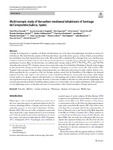Mostrar o rexistro simple do ítem
Multi-Isotopic Study of the Earliest Mediaeval Inhabitants of Santiago de Compostela (Galicia, Spain)
| dc.contributor.author | Pérez-Ramallo, Patxi | |
| dc.contributor.author | Grandal-d'Anglade, Aurora | |
| dc.contributor.author | Organista, Elia | |
| dc.contributor.author | Santos, Elena | |
| dc.contributor.author | Chivall, David | |
| dc.contributor.author | Rodríguez-Varela, Ricardo | |
| dc.contributor.author | Götherström, Anders | |
| dc.contributor.author | Etxeberría Gabilondo, Francisco | |
| dc.contributor.author | Ilgner, Jana | |
| dc.contributor.author | Fernandes, Ricardo | |
| dc.contributor.author | Arsuaga, Juan Luis | |
| dc.contributor.author | Le Roux, Petrus | |
| dc.contributor.author | Higham, Tom | |
| dc.contributor.author | Beaumont, Julia | |
| dc.contributor.author | Koon, Hannah | |
| dc.contributor.author | Roberts, Patrick | |
| dc.date.accessioned | 2023-01-16T19:10:11Z | |
| dc.date.available | 2023-01-16T19:10:11Z | |
| dc.date.issued | 2022-10-12 | |
| dc.identifier.citation | Pérez-Ramallo, P., Grandal-d´Anglade, A., Organista, E. et al. Multi-isotopic study of the earliest mediaeval inhabitants of Santiago de Compostela (Galicia, Spain). Archaeol Anthropol Sci 14, 214 (2022). https://doi.org/10.1007/s12520-022-01678-0 | es_ES |
| dc.identifier.issn | 1866-9565 | |
| dc.identifier.uri | http://hdl.handle.net/2183/32358 | |
| dc.description.abstract | [Abstract] Santiago de Compostela is, together with Rome and Jerusalem, one of the three main pilgrimage and religious centres for Catholicism. The belief that the remains of St James the Great, one of the twelve apostles of Jesus Christ, is buried there has stimulated, since their reported discovery in the 9th century AD, a significant flow of people from across the European continent and beyond. Little is known about the practical experiences of people living within the city during its rise to prominence, however. Here, for the first time, we combine multi-isotope analysis (δ13C, δ15N, δ18Oap, δ13Cap and 87Sr/86Sr) and radiocarbon dating (14C) of human remains discovered at the crypt of the Cathedral of Santiago to directly study changes in diet and mobility during the first three centuries of Santiago’s emergence as an urban centre (9th–12th centuries AD). Together with assessment of the existing archaeological data, our radiocarbon chronology broadly confirms historical tradition regarding the first occupation of the site. Isotopic analyses reveal that the foundation of the religious site attracted migrants from the wider region of the northwest corner of the Iberian Peninsula, and possibly from further afield. Stable isotope analysis of collagen, together with information on tomb typology and location, indicates that the inhabitants of the city experienced increasing socioeconomic diversity as it became wealthier as the hub of a wide network of pilgrimage. Our research represents the potential of multidisciplinary analyses to reveal insights into the origins and impacts of the emergence of early pilgrimage centres on the diets and status of communities within Christian mediaeval Europe and beyond. | es_ES |
| dc.description.sponsorship | This project has been supported by a grant from the ‘la Caixa’ Banking Foundation (ID 100010434; Code: LCF/BQ/ES16/11570006). Patxi Pérez-Ramallo and Patrick Roberts would also like to thank the Max Planck Society for funding for this project. Patxi Pérez-Ramallo, Hannah Koon and Julia Beaumont would like to thank the University of Bradford for funding a support the first osteological and stable isotope analysis conducted in 2015. Two of the isotopic analyses and 14C dates have been carried out with funding from the Xunta de Galicia to the CulXeo Group (ED431B 2018/47) and to the research network ‘Cultural Heritage, archaeological and technical services’ (R2016/023) | es_ES |
| dc.description.sponsorship | Fundación "La Caixa"; LCF/BQ/ES16/11570006 | |
| dc.description.sponsorship | Xunta de Galicia; ED431B 2018/47 | |
| dc.language.iso | eng | es_ES |
| dc.publisher | Springer Link | es_ES |
| dc.relation.uri | https://doi.org/10.1007/s12520-022-01678-0 | es_ES |
| dc.rights | Atribución 4.0 Internacional | es_ES |
| dc.rights.uri | http://creativecommons.org/licenses/by/4.0/ | * |
| dc.subject | Paleodiet | es_ES |
| dc.subject | Mobility | es_ES |
| dc.subject | Camino de Santiago | es_ES |
| dc.subject | Pilgrimage | es_ES |
| dc.subject | Santiago de Compostela | es_ES |
| dc.subject | Middle Ages | es_ES |
| dc.title | Multi-Isotopic Study of the Earliest Mediaeval Inhabitants of Santiago de Compostela (Galicia, Spain) | es_ES |
| dc.type | info:eu-repo/semantics/article | es_ES |
| dc.rights.access | info:eu-repo/semantics/openAccess | es_ES |
| UDC.journalTitle | Archaeological and Anthropological Sciences | es_ES |
| UDC.volume | 14 | es_ES |
| UDC.startPage | 214 | es_ES |
| dc.identifier.doi | 10.1007/s12520-022-01678-0 |
Ficheiros no ítem
Este ítem aparece na(s) seguinte(s) colección(s)
-
IUX-CULXEO - Artigos [63]






